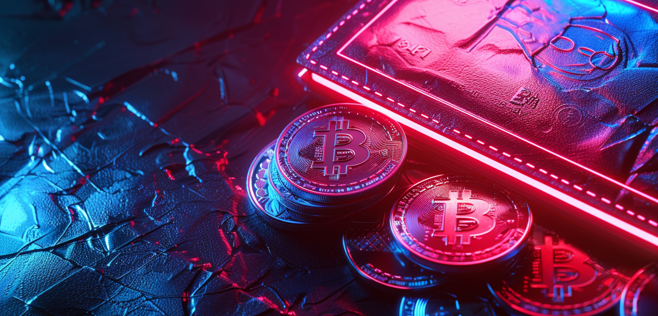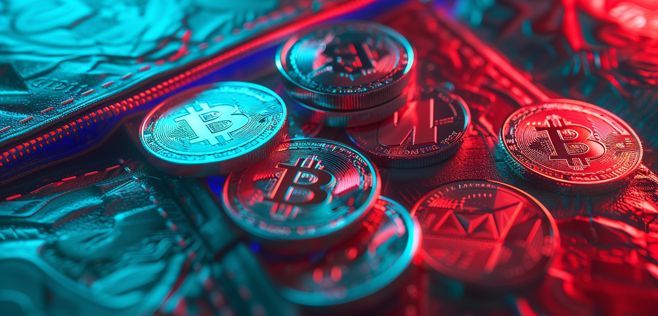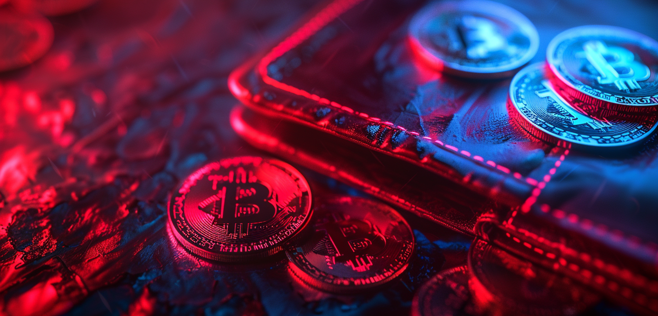Published 22 Apr 2025
The Smart Investor's Guide to Best Crypto Wallets 2025 (With Security Tips)

Choosing the right crypto wallet in 2025 is one of the most important decisions for any investor entering the digital asset space.
The crypto world keeps evolving. Platforms like Coinbase now dominate U.S.-based exchanges, and wallet providers support hundreds of cryptocurrencies. Today’s wallets offer much more than simple storage — they support complex DeFi transactions with fees ranging from 0% to 0.26%.
More young investors are turning to cryptocurrencies and NFTs instead of traditional stocks. And protecting these digital assets starts with picking a secure, reliable wallet. This guide breaks down the different types of crypto wallets and helps you choose the one that fits your needs.

Understanding the Types of Crypto Wallets
Crypto wallets work as your gateway to the blockchain world, but they don't actually store cryptocurrencies. These wallets protect your private keys that you need to access and manage digital assets on the blockchain. Learning about different types of crypto wallets helps you pick the best crypto wallet 2025 that matches your investment strategy.
Hot wallets vs cold wallets
The biggest difference between hot and cold wallets comes down to internet connectivity. Hot wallets stay connected to the internet, which makes them easy to use for frequent transactions but leaves them open to security risks. Cold wallets work offline and give you better protection against online attacks, but you'll need extra steps to make transactions.
Hot wallets create and keep private keys online, so you can easily access your cryptocurrencies from anywhere. New users and active traders love them because they can quickly get to their funds. These wallets usually come free, which removes any upfront costs.
Cold wallets put security first, ahead of convenience, by keeping private keys offline. This creates a strong defense against hackers and remote attacks. Long-term investors with large holdings will find cold wallets the safest option right now. In spite of that, the offline setup means regular transactions take more work because you need to connect to an online device to transfer funds.
Smart investors often use both types of wallets — hot ones for everyday transactions with smaller amounts and cold storage for bigger, long-term investments.
Custodial vs non-custodial wallets
Private key control makes all the difference between custodial and non-custodial wallets. Custodial wallets let a third party, like an exchange, manage your private keys, just as traditional banks handle regular money. These platforms offer password recovery and user-friendly designs that new users find easy to handle.
Coinbase and other big exchanges provide custodial wallet services and handle security by keeping most customer funds in cold storage. The convenience is great, but custodial wallets come with risks — your assets could be in danger if the exchange gets hacked or goes bankrupt.
Non-custodial wallets put you in full control of your private keys with no middlemen. This matches crypto's core idea of financial freedom — you might have heard "not your keys, not your coins". The freedom comes with big responsibilities though — lose your keys or recovery phrase and your funds are gone forever.
Most non-custodial wallets give you a seed phrase (usually 12-24 words) during setup as a backup option. Anyone who has this phrase can recreate the wallet and access all funds, so keeping it safe is crucial.
Hardware, software, and paper wallets
Software wallets run as apps on desktops, phones, or web browsers. Desktop wallets pack more features for managing crypto and working with decentralized apps, but they store data on computers that might not be secure. Mobile wallets excel at convenience with QR code scanning and up-to-the-minute notifications, though they can fall victim to SIM swap attacks and other mobile threats.
Hardware wallets lead the pack in cold storage solutions, looking like USB drives that physically store private keys. These devices cost between $50-$200 and sign crypto transactions automatically without exposing keys to internet-connected devices. Top brands like Ledger and Trezor use secure chips to isolate private keys, making them almost impossible to hack remotely.
Paper wallets, which used to be popular, are printed documents with public and private keys, sometimes as QR codes. While they're safe from online threats, paper wallets have lost favor because they can get damaged or lost too easily. Creating secure paper wallets needs offline generators to keep keys safe from compromise.
The best cold storage wallet needs more than just security. The most secure crypto wallet should balance protection with ease of use, support your favorite cryptocurrencies, and match your tech skills. Your wallet setup might need changes as your investment strategy grows to keep security and accessibility just right.

Match the Wallet to Your Investor Profile
Finding the right crypto wallet means matching the tech with how you invest. Every investor has their own goals and habits. That's why wallets come with different features that fit various ways people use them. Your first step to finding the best crypto wallet 2025 is knowing your investor style. This helps balance security and availability based on what you need.
To long-term holders: cold storage options
"HODLers" — the long-term cryptocurrency investors — put security above everything else. Cold storage wallets give these investors the best way to protect their digital assets. These wallets stay offline and offer unmatched protection from online threats. Hackers can't touch them remotely.
Serious long-term investors prefer hardware wallets as their go-to cold storage method. These physical devices keep private keys completely offline. They connect to computers or phones only to sign transactions. The private keys stay safe inside the device even during connections. This security stays intact no matter what device you connect to.
Ledger and Trezor's best cold storage options pack some serious security features:
- Two-factor authentication adds extra protection
- Encryption protocols guard private keys and transaction data
- Seed phrase backups help if you lose or damage the device
Cold storage makes sense because about 20% of all crypto coins have disappeared through theft, software bugs, or broken hardware. Investors who plan to hold their assets without many transactions get peace of mind from this solid security approach.
To active traders: hot wallets with fast access
Active traders just need quick access to their crypto. Market moves wait for no one, so these traders need wallets that work fast. They must jump on good deals the moment they show up.
Hot wallets stay connected to the internet all the time. This means you can trade right away and smoothly. They shine because they offer:
- Quick access without extra devices
- Simple trading screens that work great for frequent moves
- Direct links to crypto exchanges and trading platforms
Many hot wallets let you handle multiple cryptocurrencies in one place. This makes life easier for traders who hold different digital assets. You'll love this feature when markets move fast and you need to switch between currencies quickly.
Hot wallets might be handy, but active traders should add extra security steps. These wallets face online risks, so experts say to keep just what you need for daily trading. The rest should stay in cold storage. This way, you get easy access without risking your whole portfolio.
To beginners: simple and secure mobile wallets
New crypto users need wallets that focus on user experience and clear security features. Beginners care most about wallets that are easy to use and offer clear guidance with a simple interface.
Mobile wallets work best for crypto newcomers. They keep things simple with:
- Clean, easy-to-use designs
- Guides that walk you through setup
- Simple backup and recovery options
Trust Wallet shows how this works with its mobile design that's both flexible and easy to use. Binance owns it, and beginners can manage various cryptocurrencies right from their phones. Coinbase Wallet also keeps things user-friendly while staying secure. You control your private keys and can easily use Coinbase's exchange.
New investors might start with custodial wallets where someone else handles security. These platforms usually help you recover passwords and are easy to use — perfect while learning crypto basics. As your knowledge and holdings grow, you can switch to non-custodial wallets for complete control over your private keys.
The safest strategy often means using different wallet types as your needs change. Many experienced investors use both hot and cold wallets. They keep small amounts in hot wallets for daily use and bigger, long-term holdings in cold storage.

Top Crypto Wallets in 2025 by Use Case
The crypto market in 2025 has countless wallet options. Finding the right solution for your needs can be tricky. Let's get into the best crypto wallet 2025 options based on different user needs and their standout features.
Best crypto wallet for beginners
Coinbase Wallet has become the top pick for crypto newcomers in 2025. This easy-to-use hot wallet makes onboarding smooth with a simple interface. The wallet runs on one of the world's biggest crypto exchanges and comes with strong security that updates weekly.
Users can access more than 5,500 cryptocurrencies through Coinbase Wallet. The platform lets you adjust network fees for transactions, which helps new users learn to manage costs better.
BlueWallet gives beginners another great option with its straightforward mobile experience built for Bitcoin users. The wallet combines simplicity with security through multi-signature protection and decoy PINs.
Best cold storage wallet for long-term security
Ledger Nano S Plus tops the list of hardware wallets for long-term investors who need maximum security. This small device keeps private keys offline and shows everything on a clear digital display. The certified secure chip protects against physical tampering, making it almost impossible to hack.
Trezor Safe 3 gives users who prefer open-source options excellent security through code transparency. The community can audit the software, which reduces hidden vulnerability risks. Users don't have to trust manufacturer claims — they can check the wallet's security themselves.
KeepKey works well for beginners moving to hardware wallets. The wallet comes at a good price point with a big, clear digital display that makes hardware wallet use simple without cutting corners on security.
Best wallet for DeFi and staking
Crypto.com DeFi Wallet leads in decentralized finance with its detailed DeFi tools and strong security setup. This non-custodial wallet lets you stake different cryptocurrencies, use lending protocols, and tap into yield farming — all from one place.
Phantom Wallet started with Solana but now works with Ethereum and Polygon too. The wallet shines at staking with both native options and liquid staking through Jito. You can stake assets right in the wallet and get tokenized versions to use in DeFi protocols.
MetaMask remains crucial for Ethereum-based DeFi by connecting smoothly to decentralized exchanges and lending platforms. The extensive dApp browser makes it valuable for active Ethereum users.
Best Bitcoin-only wallet
Electrum stands out for dedicated Bitcoin users who know their tech. Running since 2011, this specialized wallet offers top Bitcoin security with multi-signature authorization and hierarchical deterministic features. The open-source code gets constant peer review to boost security.
BitBox02 Bitcoin Edition gives Bitcoin investors another solid choice. This hardware wallet uses Bitcoin-only firmware to cut down potential risks from supporting multiple coins. The focused approach lets BitBox add Bitcoin-specific security while working well with popular Bitcoin software like Electrum and Wasabi.
BlueWallet hits the sweet spot for mobile Bitcoin users by mixing simplicity with security. The wallet makes Bitcoin management available through simple batch features for storing, sending, and receiving. Lightning Network integration means faster transactions at lower costs.

How to Choose the Best Crypto Wallet for You
Picking the right cryptocurrency wallet takes more than just going with a popular brand. Security features matter, but you should also think about several key factors that line up with your needs and investment strategy. The best crypto wallet 2025 needs to strike the right balance between security, functionality, and convenience that fits your crypto trip.
Assess supported coins and tokens
You won't find a wallet that supports every cryptocurrency out there. Your portfolio needs must match what the wallet can handle. Hardware wallets like Ledger support over 15,000 different cryptocurrencies, making them perfect for diverse portfolios. Trust Wallet goes even further by supporting millions of assets on more than 100 blockchains.
Each wallet shines in different ecosystems:
- MetaMask works best with Ethereum-based tokens and applications
- Keplr specializes in the Cosmos ecosystem
- Edge supports many blockchains but might not have complete Web3 functionality
Make sure your chosen wallet supports both your current holdings and any crypto you plan to buy later. Supporting multiple currencies means you won't need separate wallets for different coins, which makes your investment process smoother.
Check device compatibility and user-friendliness
Your lifestyle and technical priorities play a big role in choosing the right wallet type. Hot wallets run in web browsers or as mobile/desktop apps, while cold wallets come as hardware devices or paper-based solutions.
Here's what to look for in compatibility:
- Platform support – some wallets only work on specific operating systems
- Mobile access – vital if you need to manage your crypto on the go
- Desktop functionality – offers better features and visualization tools
Knowing how to access your wallet from anywhere becomes significant, especially when you have to make quick trades. The wallet should offer a stable, user-friendly interface that shows your crypto holdings clearly.
Coinbase Wallet and Trust Wallet do great with cross-platform compatibility. They work smoothly on both mobile and desktop. Coinomi has improved its apps to work well on iOS and Android, and its desktop versions make access even easier.
Look for integration with exchanges and dApps
Good integration makes shared functionality possible beyond simple storage. Connecting with exchanges and decentralized applications creates an uninterrupted ecosystem for trading, staking, and using cryptocurrencies.
Key integration features include:
- Direct purchasing options – buying crypto with bank accounts or payment cards
- Exchange connectivity – easy transfers between wallets and trading platforms
- DApp browsers – direct access to decentralized applications
Business users need wallets that work with their financial systems like accounting software and payment gateways. This connection reduces manual data entry errors and helps track finances in real-time.
Trust Wallet shows excellent exchange integration. It connects easily to platforms like Binance and Coinbase for direct deposits. DeFi users love wallets like MetaMask because they connect well with Ethereum-based applications, making them more than just storage tools.
Keep in mind the simple security practices. Turn on two-factor authentication when available, stay away from suspicious links, keep your holdings private, and never give out your private keys. Hardware wallet compatibility matters most for serious investors since these devices add security by keeping private keys offline.

Security Features to Look For in a Wallet
Security tops the list of concerns when choosing a cryptocurrency wallet in 2025. The best crypto wallet 2025 options use multiple protection layers to keep digital assets safe. Knowing these key security features helps investors choose solutions that protect their cryptocurrency holdings well.
Two-factor authentication and PIN protection
Two-Factor Authentication (2FA) creates a vital second security layer beyond passwords. Users need two different forms of identification to access their account, which makes unauthorized access nowhere near as easy. Cryptocurrency platforms usually combine something you know (password or PIN) with something you have (mobile device or hardware token).
The most secure crypto wallets offer several 2FA options:
- Authenticator apps that generate time-sensitive codes
- SMS verification codes (less secure than app-based options)
- Biometric verification using fingerprints or facial recognition
App-based 2FA gives better protection than SMS-based methods because SMS can fall victim to SIM swap attacks. The safest crypto wallet options use authenticator apps like Google Authenticator or Authy to verify users.
PIN protection adds another security layer that stops unauthorized access if someone gets hold of your physical device. Hardware wallets need this feature to build a strong defense system for your digital assets.
Seed phrase backup and recovery options
Seed phrases work like master keys to cryptocurrency wallets and let you recover access if you lose it. These phrases usually have 12-24 random words that create private keys to restore wallet access on new devices.
Security experts recommend these steps:
- Make physical copies of seed phrases (never digital)
- Keep backups in several secure places
- Use fireproof and waterproof containers
- Think about metal storage devices for durability
The most secure crypto wallet options focus on proper seed phrase handling. Some wallets have improved this system with state-of-the-art features like multi-signature recovery, where you need multiple keys to approve transactions. Your funds stay safe even if someone compromises one recovery method.
Seed phrases must stay offline and private because anyone with this information gets full access to your digital assets. Good recovery systems help investors keep access to their funds while maintaining strong security.
Open-source code and community audits
Open-source wallets show complete transparency by sharing their code publicly. Security researchers and developers can check, verify, and improve the wallet's development, which builds trust in the crypto community.
Open-source wallets offer these security benefits:
- Independent experts can verify code openly
- Teams find and fix vulnerabilities faster
- Community collaboration leads to constant improvements
Many types of crypto wallets rely on community audits to boost security. More developers checking the code means they find potential risks that might stay hidden in closed-source options. This team approach creates safer wallets through shared expertise and ongoing review.
Transparency stands as a core value in cryptocurrency, and open-source wallets show this by letting users see exactly how their assets stay protected. Investors who care about security should pick wallets with clear code and active community involvement to feel more confident about their digital asset protection.

Maintaining and Upgrading Your Wallet Over Time
Your wallet maintenance matters just as much as your original wallet choice. Many crypto investors only focus on choosing the best crypto wallet 2025 without thinking about how their storage needs might change. A regular review of your wallet strategy will give a better protection as technology advances and your needs evolve.
When to switch wallets
You'll notice several signs that tell you it's time to upgrade your wallet. You might need a switch when your current wallet stops supporting new cryptocurrencies you want to buy. A move to a new wallet becomes necessary if your assets have grown too large, making cold storage a better choice than hot wallets.
Users who start with custodial solutions should move to self-custody options as they learn more. This change happens naturally as investors get comfortable with basic cryptocurrency management. People often buy hardware wallets after their investment value grows because physical devices protect larger holdings better.
How to safely migrate your assets
Moving assets between wallets needs careful attention. Set up your new wallet first and store its recovery phrases offline securely. Send a small test amount before moving larger sums to verify the destination address works correctly.
Your wallet needs enough ETH to cover network fees when moving ERC-20 tokens. Check all addresses twice during migration because wrong destinations mean permanent loss. Multi-signature options add extra verification for large transfers.
Staying updated with wallet software
Software updates fix security gaps that hackers target. Maybe outdated wallet software poses one of the biggest risks to cryptocurrency holdings that you can prevent. Turn on automatic updates to stay protected against new threats.
Security practices should include encrypted backup drives and regular checks of your transactions. Learning about the latest security updates in cryptocurrency storage helps protect your assets long-term. Open-source wallet's security patches arrive faster thanks to community input and ongoing peer review.

Conclusion
Choosing the right cryptocurrency wallet plays a vital role in protecting digital assets in 2025. Bitcoin and other cryptocurrencies have grown rapidly, making secure storage a must for investors of all levels.
Smart investors know their wallet needs will change as time goes on. A user-friendly mobile wallet works great at the time you start, but growing portfolios just need better security through hardware wallets. It also makes sense to use different wallet types together to strike the perfect balance of convenience and protection.
Whatever wallet you pick, security should be your top priority. Your investments stay safe with regular software updates, proper seed phrase storage, and a careful look at supported features. Investors can join the growing cryptocurrency ecosystem with confidence by maintaining their wallets and following security best practices.
The smartest way to think about wallet selection is as an ongoing journey rather than a single choice. Your cryptocurrency holdings will grow and technology will advance, so you should assess your storage solutions and upgrade them when needed. This hands-on approach will give a solid shield to your digital assets now and in years ahead.
Read More




 Get RateX Pro
Get RateX Pro

 06 Jun 2024
06 Jun 2024
